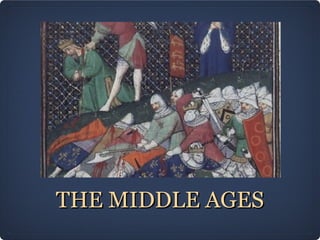
Middle ages part 1
- 1. THE MIDDLE AGESTHE MIDDLE AGES
- 2. THE RISE OF THE FRANKS • After the Western Roman Empire collapsed, many Germanic tribes (Visigoths, Vandals, Burgundians, and Ostrogoths) plundered Europe and established small kingdoms.
- 3. • Of these tribes, the Franks will become the most influential and significant. • The Franks entered the Roman Empire near the mouth of the Rhine in 250 BCE. • They settled in the area of Northern Gaul that corresponds to present day Belgium and the Netherlands.
- 4. King Clovis • In AD 481 ( 481 CE), an able ruler by the name of Clovis became king of one of the Frankish tribes. • Hi lineage is known as the Merovingians. (Because it is traced back to their ancestor Merovech). • Clovis was an impressive military commander and the Franks would dominate all of Northern Gaul.
- 5. • The legend says that Clovis had vowed to his christian wife (Princess Clotilde) that he would become a christian himself if he won a victory at Tolbiac, which he did. He also ordered 3,000 of is soldiers to convert to Christianity. • This gave Clovis the support of the Catholic church. • Clovis later seized western Gaul from the Visigoths.
- 6. • Clovis' sons divided the kingdom among themselves. • The Merovingian line would become increasingly weak. • Eventually, the real power will be held not by the Merovingian kings, but by the officials known as the Mayor of the Palace became the real power.
- 8. • Pepin II, a mayor of the palace, ruled from 687 to 714 and eventually his line unified the Franks. • His son, Charles Martel (The Hammer) .
- 9. • in 732, the Muslims of Spain (The Moors) invaded France and were defeated by Martel in the Battle of Tours. • In 741, Martel died and left his sons Pepin and Carloman a strong kingdom to rule. • Carloman entered monastic life and his brother, Pepin III, also known as Pepin The Short, became the sole ruler.
- 10. • In 751, the pope traveled to France and crowned Pepin 'King by the Grace of God'. • With this coronation we have the Carolingian dynasty. • The blessing of the church will become extremely important through the middle ages and beyond, to the point that church, nation and king will be closely intertwined.
- 11. • The Pope in turn, asked Pepin for help against the Lombards, a Germanic tribe in the outskirts of Rome that was threatening them. • Pepin defeated the Lombards and gave the lands to the Catholic Church, increasing its power and creating what would be known for centuries as 'The Papal States'.
- 12. Charlemagne's Empire • Pepin's on, Charlemagne (Carolus Magnus, Charles the Great) ascended the throne in AD 768 and ruled until 814. • He is known as one of history's most outstanding rulers.
- 13. • Charlemagne defeated the Lombards in Italy, the Saxons in Germany and the Avars in central Europe. • He could not conquer the Moors of Spain, but he pushed them back across the Pyrenees. • By the end of his rule, he controlled much of western Europe. • His motto was 'Renovatio imperi romani' (Renewal of the Roman Empire).
- 14. • Charlemagne had united much of Europe for the first time since the fall of Western Rome, and when Pope Leo III placed a crown on his head and declared him 'Emperor of the Romans' in Saint Peter's church in Rome, it had nothing to do with the actual old Roman Empire, but with his standing in the eyes of the people as successor of the emperors of Rome.
- 15. • Charlemagne's rule levied no taxes on land or people, because his estates produced more than enough revenue to sustain the Empire. (WOW!) • His Empire was made of several hundred regions, each run by a Count. Each region had its own army and administered its own laws. • He had officials called missi dominici (The Lord's Messengers), who traveled all around the empire listening to complaints and evaluating the laws and rulers, keeping an eye on the counts and reporting to Charlemagne.
- 16. • Charlemagne was greatly interested in education and he created a school at his palace for his children and nobles. • He invited scholars (mostly monks) from all over Europe to teach at his school. • He had commissioned a readable bible, the Carolingian Bible. It became the standardized bible for Charlemagne's empire. • He ordered Bishops to salvage and copy ancient Latin Manuscripts and to organize schools for the children of nobles and promising children from lower classes.
- 17. • Charlemagne never learned to write, but he knew how to read, his favorite book was Saint Augustine's City of God.
- 18. Downfall • After Charlemagne's death, his son Louis The Pious took power. • After Louis's death, his sons Lothair, Louis the German and Charles the Bald divided the kingdom into eastern, western and middle. • This was done with the Treaty of Verdun.
- 19. The Vikings • The empire of Charlemagne collapsed, not only because of internal disputes, but through foreign invasions, particularly, the Vikings. (Danes, Norse, Northmen).